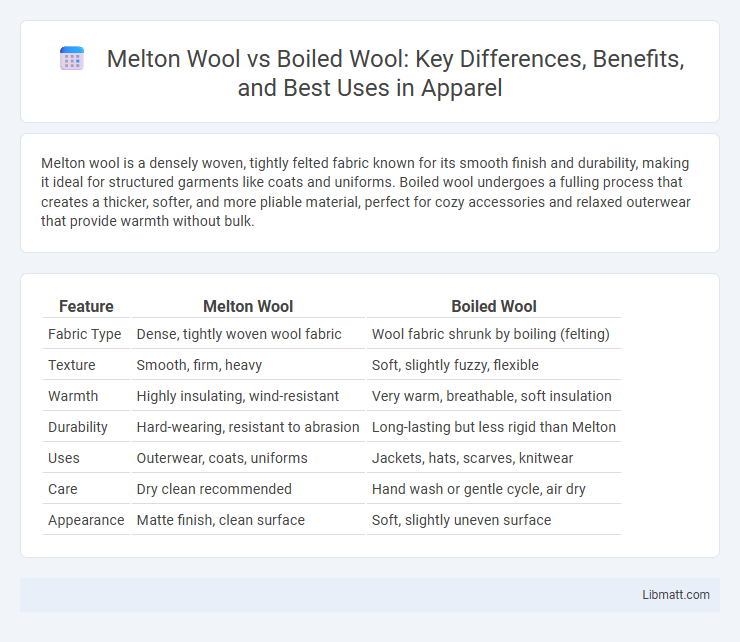Melton wool is a densely woven, tightly felted fabric known for its smooth finish and durability, making it ideal for structured garments like coats and uniforms. Boiled wool undergoes a fulling process that creates a thicker, softer, and more pliable material, perfect for cozy accessories and relaxed outerwear that provide warmth without bulk.
Table of Comparison
| Feature | Melton Wool | Boiled Wool |
|---|---|---|
| Fabric Type | Dense, tightly woven wool fabric | Wool fabric shrunk by boiling (felting) |
| Texture | Smooth, firm, heavy | Soft, slightly fuzzy, flexible |
| Warmth | Highly insulating, wind-resistant | Very warm, breathable, soft insulation |
| Durability | Hard-wearing, resistant to abrasion | Long-lasting but less rigid than Melton |
| Uses | Outerwear, coats, uniforms | Jackets, hats, scarves, knitwear |
| Care | Dry clean recommended | Hand wash or gentle cycle, air dry |
| Appearance | Matte finish, clean surface | Soft, slightly uneven surface |
Introduction to Melton Wool and Boiled Wool
Melton wool is a densely woven, tightly felted fabric known for its smooth surface and heavyweight warmth, commonly used in outerwear and uniforms. Boiled wool, created by aggressively shrinking and felting knitted wool, offers a thick, dense texture with natural water resistance and flexibility. Both fabrics excel in insulation and durability, but Melton wool features a cleaner finish while boiled wool provides enhanced elasticity and softness.
Manufacturing Processes: Melton vs. Boiled Wool
Melton wool is produced through a tightly woven twill weave that undergoes a fulling process, where the fabric is brushed and felted to create a dense, smooth surface with a slight nap. Boiled wool results from knitting or weaving wool fabric followed by a vigorous boiling and felting process, which shrinks and thickens the material, giving it a soft, dense, and durable texture. The key manufacturing distinction lies in Melton's woven construction and finishing versus boiled wool's use of felted knit or woven fibers.
Texture and Appearance Differences
Melton wool features a dense, smooth, and tightly woven texture with a slightly felted surface that gives it a clean, polished appearance, ideal for outerwear and structured garments. Boiled wool is softer, thicker, and fuzzier due to the fulling process that shrinks and matts the fibers, resulting in a plush, textured finish that offers warmth and flexibility. Your choice between Melton wool and boiled wool depends on whether you prefer a crisp, refined look or a cozy, textured feel in your fabric.
Durability and Longevity Comparison
Melton wool, renowned for its densely woven, felt-like texture, offers exceptional durability and resistance to wear, making it ideal for outerwear that withstands harsh conditions. Boiled wool, produced by felting woven wool fabric, provides a softer and more flexible option but generally exhibits less durability compared to Melton due to its lighter weight and structure. Over time, Melton wool maintains shape and insulation properties better, ensuring longer garment longevity and sustained performance in colder climates.
Warmth and Insulation Properties
Melton wool offers excellent warmth and insulation due to its tightly woven, densely felted fabric, which effectively traps heat and blocks wind. Boiled wool, created by fulling and shrinking wool fibers, provides superior insulation by enhancing fiber density while maintaining breathability and flexibility. Your choice between Melton and boiled wool will depend on whether you prioritize wind resistance or a softer, more flexible layer for cold weather protection.
Water Resistance and Weather Performance
Melton wool exhibits superior water resistance due to its tightly woven, dense structure that repels moisture effectively, making it ideal for outdoor wear in damp conditions. Boiled wool, created by felting and shrinking wool fibers, offers moderate water resistance but is less effective against heavy rain compared to Melton wool. Both materials provide excellent insulation and wind resistance, but Melton wool's enhanced weather performance makes it preferable for harsher climates.
Common Uses in Fashion and Textiles
Melton wool is widely used in outerwear such as coats and jackets due to its dense, tightly woven structure that provides excellent wind resistance and durability. Boiled wool, softer and more flexible, is favored for scarves, hats, and gloves, offering warmth with a lighter, more comfortable feel. Both textiles are popular in crafting high-quality, stylish garments that emphasize insulation and texture in fall and winter fashion.
Maintenance and Care Requirements
Melton wool requires gentle cleaning, typically dry cleaning, to preserve its dense texture and prevent shrinkage, while boiled wool is more resilient to hand washing with mild detergent due to its felted nature. Both fabrics benefit from air drying flat to maintain shape and avoid stretching, but boiled wool's felted fibers make it less prone to pilling and easier to care for in everyday use. You can extend the lifespan of either fabric by avoiding excessive heat and friction during cleaning and storage.
Environmental Impact and Sustainability
Melton wool is densely woven and tightly felted, offering durability that reduces the need for frequent replacement, contributing to lower environmental impact through longevity. Boiled wool undergoes a wet-felting process that increases insulation properties, which can enhance energy efficiency in garments and home textiles. Choosing Melton or boiled wool supports sustainable fashion by promoting biodegradable, renewable fiber use, helping Your wardrobe align with eco-friendly practices.
Choosing Between Melton Wool and Boiled Wool
Melton wool, characterized by its dense, tightly woven texture and smooth finish, offers superior wind resistance and durability, making it ideal for outerwear like coats and jackets. Boiled wool, produced by fulling or felting knitted wool, provides a softer, more flexible fabric with excellent insulation and a slightly fuzzy surface, suitable for scarves, hats, and lighter garments. Selecting between Melton wool and boiled wool depends on the desired balance between structural rigidity and warmth with comfort; Melton excels in formal, structured pieces, while boiled wool suits casual, cozy apparel.
Melton wool vs boiled wool Infographic

 libmatt.com
libmatt.com